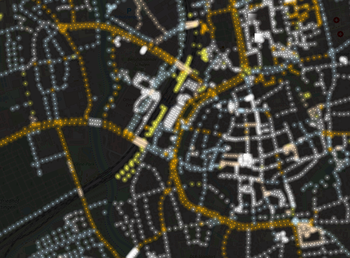Uk:Tag:highway=street_lamp
 |
| Опис |
|---|
| Окремий стовп з одним або кількома вогнями для освітлення вулиці. |
| Група: highways |
| Застосовується до цих елементів |
| Використовується разом з |
|
| Дивись також |
| Статус: де-факто |
| Інструменти |
Теґ highway=street_lamp використовується для позначення вуличного ліхтаря, вуличного світильника, ліхтарного стовпа : вертикального джерела світла над дорогою, що вмикається чи світить вночі.
Як позначати
Додайте точку у місці, де фактично розміщено джерело світла (наприклад, поруч до освітленої дороги).
Теґ highway=street_lamp використовується лише на ![]() точках.
точках.

highway=street_lamp
ref=*якщо на ліхтарі є номер, що дозволяє допомогти ідентифікувати точки на дорозі. Зокрема, у деяких місцях ви можете викликати поліцію і сказати, що трапилася дорожньо-транспортна пригода на Big Street, південніше ліхтарного стовпа 35, і поліція буде точно знати, де це є. Ці ідентифікатори також можуть використовуватися для повідомлення про розбиті лампи чи розміщення реклами.

lamp_ref_swd=*теґ використовується лише у місті Дюссельдорф для ліхтарів, що не використовуються у навігації (див. нижче).
Використовуйте також lit=yes на вулицях та інших об'єктах, що освітлені вуличним ліхтарем. Якщо ліхтар не є прожектором чи юпітером буває складно визначити наскільки розповсюджується світло, щоб вважати вулицю неосвітленою, тому використовуйте lit=yes для тих сегментів, де розташовано ліхтарі. lit_by_gaslight=yes також використовується деякими містами, щоб позначити, що дорога освітлюється саме газовими ліхтарями.
Стандартні атрибути
Зверніть увагу, що ці атрибути не пройшли формальної процедури затвердження, але використовуються.
| Ключ | Значення |
|---|---|
support=*
|
Як розміщується світловий елемент. Приклади:
|
lamp_mount=*
|
Якщо є теґ support=pole, тоді:
Інші використовувані значення (з надмірністю до значень
|
lamp_type=* (або менш поширено light:method=*):
|
|
light:colour=*
|
Якщо лампа не є спеціально декоративною, муніципальне вуличне освітлення буде майже виключно або orange, або white (натрій) або white (все інше), а будь-які зміни кольору спричинені або старінням лампи, або накопиченням бруду, або варіаціями обраної колірної температури.
|
light:count=*
|
Кількість світильників на стовпі. (Для світлодіодних ламп рахуються модулі, а не окремі діоди). |
light:lit=*
|
Час доби, коли вмикається світло.
|
light:shape=*
|
Визначає форму лампи.
|
light:tilt=*
|
-90 для спрямування на вулицю/тротуар, 0 для бічних шляхів, 90 для вказівки вгору, і все, що між ними
|
light:direction=*
|
Числовий напрямок на мапі, припускаючи, що ліхтар має один стовп (0=північ, 90=схід і т.д.), на який вказує ліхтар. Якщо на одному стовпі є 2 ліхтарі, їх можна позначити, наприклад, 70;250
Дивіться також |
lamp_model=*
|
Тип або марка/модель світильника (корпусу) |
manufacturer=*
|
Виробник світильника (корпусу) |
model=*
|
Модель світильника (корпус) |
light:model=*
|
Тип (марка/модель) «лампочки» |
ref=*
|
Реєстраційний номер, що використовується оператором (наприклад, окружною радою), зазвичай позначається на табличці, прикріпленій до опори |
Variations (not currently tagged)
The suspending is commonly done by placing the lamp on top of a pole at the edge of a road or between lanes. Lamps may be mounted on the middle of a roadside power pole instead of a dedicated pole, although the latter may support low voltage power lines (power=minor_line) for electricity supply for the lamps. Another common scheme is to have the poles hold up a suspended carrying wire from which the lamp(s) hang.
In cities, the existing buildings sometimes replace the poles in either scheme. Occasionally, street lamps are attached to other structures of convenient height, such as bridges or road signs.
The mechanism and procedures for turning off and on street lamps vary a lot. Common schemes include turning them on/off at fixed times using a clock, turning them on/off a fixed interval from sunset/sunrise using a more complex clock, turning them on based on a light sensor (which tends to also turn them on in some weather conditions) and turning them off again late at night when there is less traffic. Some schemes also involve only turning on every second street lamp some of the time.
Rendering

 - Humanitarian_map_style - Map link
- Humanitarian_map_style - Map link- Lamp map from sb12 (sb12/OSMStreetLight GitHub) using Overpass/Javascript/HTML for continuous rendering
- F4 Map and OSM2World show street lamps in their 3D maps.
- www.mapcontrib.xyz with MapContrib
Regional variations
Some cities have unique street lighting systems. See their respective pages for local tagging suggestions:
- Cincinnati (traffic island lights or turtle lamps)
Düsseldorf
Currently there is a project to map all gaslighted ![]() streets and all gaslight
streets and all gaslight ![]() lanterns in the town of Düsseldorf.
See: Düsseldorf/Projekte/Gaslaternen
lanterns in the town of Düsseldorf.
See: Düsseldorf/Projekte/Gaslaternen
(Many of these tags may also be applicable to electrical lamps, though no general scheme has been defined)
highway=street_lampJust as other streetlampslamp_type=gaslightShow that the energy comes from gas.lamp_operator=Stadtwerke DüsseldorfAll streetlamps in Düsseldorf are operated by this organisation.lamp_ref_swd=*The number on the lamp mast, given by the operator (SWD).lamp_model:de=*In Düsseldorf there are 5 different types of gas lamps in use.lamp_model:de=Alt-Düsseldorferlamp_model:de=Ansatzleuchtelamp_model:de=Aufsatzleuchelamp_model:de=Reihenleuchtelamp_model:de=Frankfurter
lamp_flames=*Number of flames in a lamp. There are four, six, eight or nine flames in a gas latern.lamp_mount=*Is the lamp mounted on a mast or on a wall?
Possible tagging mistakes
See also
tower:type=lighting- Poles for lighting, flood lighting columns- Proposed features/lamp - more flexible tagging of lamps, including street lamps
operator=*: "If the vast majority of a certain object in an area is operated by a certain organization and only very few by others then it may be sufficient to only tag the exceptions."